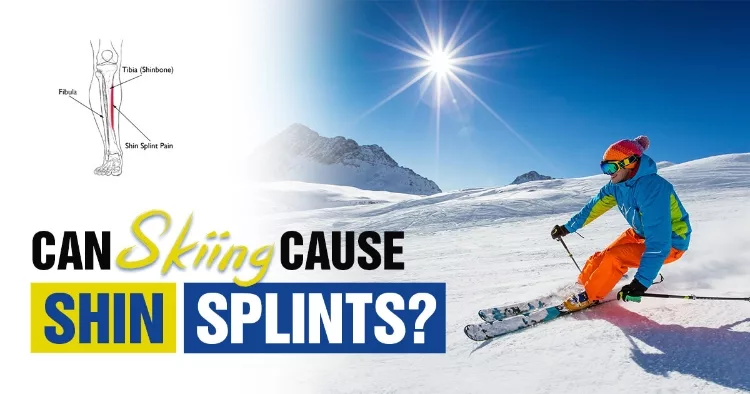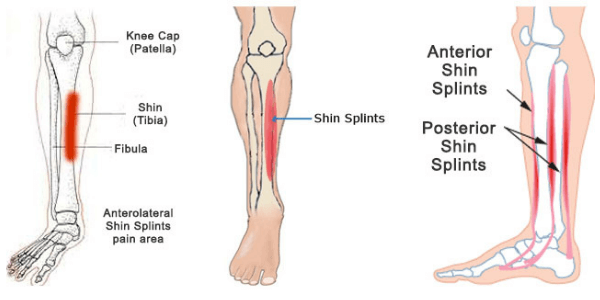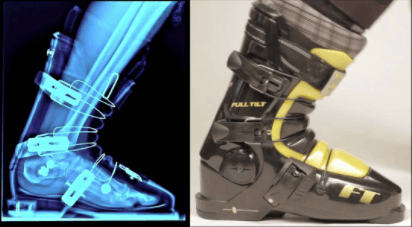Can Skiing Cause Shin Splints?
by Frank V. Persall
What is it, and what can prevent it
Like any sport, skiing has its fair share of exercise-related injuries - including shin splints. For winter sports, skiing provides a great cardiovascular workout and is a great low-impact exercise that uses most of the major muscle groups. As in other sports, such as with other professional athletes, repetitively using specific movement ranges and the associated tissue can lead to what is commonly known as overuse injuries.
Contents
Being out on the snow as a Nordic skier off-piste or a cross country skier, you will expose yourself to certain injuries, particularly if your training regime gets interrupted or you are coming back from a rest period.

One of the most common injuries experienced in both cross-country skiing and general skiing participants is shin pain. There is no one specific cause of shin pain, but it has been associated with ski boots issues where there is little flex, or the front of the boot is too stiff. It could also be related to diet and an uncoordinated approach to training and preparation.
They have also been attributed to tiring calf muscle that then exerts stress on the tendons that become strained and torn.
Can Skiing Cause Shin Splints?
If you are suffering pain in your shins while skiing, then there is a strong chance that shin splints cause the pain.
There are many possible causes of shin-bang. Usually, shin splints are more common in skiers who ski erratically throughout the ski season. The body does not get the opportunity to respond and acclimatize itself to the pressure caused.
There are some other physiological and practical factors that can make you more susceptible to a shin problem while skiing.
- Like any high-impact sport or physical exercise, you must ensure you warm your muscles up before exercise and cool down afterward when you ski. Ensure you stretch the required muscle groups and lower legs to make sure they are supple and able to prevent shin splints.
- If you have a weak ankle or tight calf muscles, this can also place pressure on your shin bone when you ski, particularly where you are constantly changing the weight spread from one side to the other.
- Being overweight and skiing can also put extra stress on your feet, legs, and ankles, causing stress.
- If you have flat feet, this can also cause you problems when you ski that might lead to shin splints.
- Poorly fitting boots or boot - your ski boot has to fit correctly to avoid shin pain.
Three common types of shin pain have been known to be experienced by the active skier. These are bony stress injury, external compartment syndrome, and shin splints. The term 'shin splints' is sometimes a general term used to refer to shin pain in athletes, when in fact, it could be one of the other shin pain conditions.
If you suffer from 'true' shin splints, or if you use its medical term Medial Tibial Stress Syndrome ( MTSS), you might suffer from pain or an unusually tender area on your shins in the tibia, shinbone area of your lower leg. It can be very sore and can impact either of your legs. Typically, shin splints will fade during warm-up or exercise and go away but then come back after exercise.
Anatomically shin splints can start to become a problem when the key muscles that control the lowering of the foot and ankle for each step, the tibialis anterior and the tibialis posterior, start to be overstretched.

A bony stress injury is a more severe condition than shin splints and usually occurs in skiers who engage in high volumes of exercise where they do not allow enough time between exercise bouts to let the bone physically heal. However, most of the time, the injury experienced is shin splints, but none the less can be painful and debilitating.
Bony stress injuries can occur anywhere on the lower leg extremities and can include both the tibia or the smaller shin bone the fibula. With a bony stress injury, the pain is much more focal on the shins than shin splints. The pain worsens with the more exercise you do, and you may have to abandon exercise - it can be that bad.
The problem is that it is hard to distinguish between a bony stress fracture and shin splints, so if symptoms persist, then it might be sensible to have an MRI scan. It is important to ensure that you adhere to strict rest if it is a bony stress fracture.
Shin Pain
You might ask, can I experience shin pain without it being shin splints? There is another condition closely related to shin splints but is usually caused by a poor-fitting ski boot - this is known as Shin Bang. The pain of shin splints, though, has characteristics such as sharp pain or dull throbbing.
What Is Shin Bang?
The difference between shin-bang, compared to shin splints is that it's not an anatomical problem. Shin Bang is normally less severe than shin splints and is a general discomfort around the shin area that is caused by irritated, bruised skin. It is traditionally caused by your skin coming into contact with the tongue, strap, or inner lining of your ski boots. The friction of your skin on your boot is the problem.
The good news for skiers is that sore shins from skiing are preventable, easy to manage, and disperse the pain.
How To Avoid Shin Bang
Ski Boot - Poorly Fitting Boots
As a skier, you know how important it is to make sure your boots fit you correctly and that they feel comfortable around your heel, ankles, and toes. You need to make sure your boots are really tight-fitting, with an easily adjustable strap to limit movement inside your ski boot. If there is movement, it is likely your boots are too big. As in other sport's shoes, ski boot brands have differing size volumes. All ski boots come with some data on the foot volume, referring to the amount of room there is up and down and side to side in the ski boot.
If you have narrow feet, you might want to try a lower volume boot fitting. The same can be said for skiers that have skinny ankles and legs. High volume boots are better for bigger, wider feet. If you are not sure, then use a professional boot fitter to test the form of the boot against your feet.
Ski Boot Flex
As a skier, you know that specific boots can be more flexible than others. Flex actually refers to how stiff the boot is, particularly the cuff of your boot. If you find that when you push forward on your boot cuff, you are being bruised instead of the cuff giving flex, the boot is too stiff.

Buckle Up
The ideal buckle situation ensures that there is no space between the shin and the tongue of the lining. Here is a suggested boot buckle routine that you should follow:
- Always start at the lower buckle first
- When that has been secured, flex the boot forward - this will make your heel slide forward, bringing your foot into the correct position and take any pressure off the toes
- Then fasten the upper cuff buckle and secure the velcro strapping
- You now have the entire cuff locked in, so flex forward again to ensure the heel is in the right place.
- Tug the tongue upward
- Then go on to fasten your toe buckles.
Few other factors can cause or aid shin bang, for example, the condition of the boot liner. The only thing that protects your foot skin from the harsh boot resin base is the soft boot liner. Therefore make sure your liner is in good and not poor condition.
Frequently Asked Questions About Shin Splints
What Is The Treatment For Shin Pain?
One of the first ports of call is to use RICE - Rest, Ice treatment, Compression, and Elevation. Keeping your legs elevated and using ice on the offending area will help to reduce any swelling that may have occurred. You could also take anti-inflammatory over-the-counter medicines, such as Ibuprofen or Advil.
Try lightly massaging your shins with foam rollers, which will help stimulate blood flow to the area.
How To Prevent Shin Splints Getting Worse?
The obvious, but not so easy to adhere to, action is to persist in the exercise that is causing the shin splints in the first place. Give yourself two weeks off at least before returning to the slopes. If you must carry on, make sure you ice the area before and afterward warm up and stretch before you begin.
Do Shin Splints Go Away?
If you rest the area and use a regime of ice and stretches, the splints should heal of their own accord. Don't ignore them. Continued exercise if you have shin splints can lead to more serious injury.
Does Heat Help Shin Splints?
Any sore area of the body that is muscularly related will respond to both cold and heat therapy. Heat therapy probably has more effect and impact if you use it 3 or 4 days after the initial injury.
Should I Consult A Doctor?
If the pain in the shin or lower legs gets worse or continues even after you have applied some treatment, you may want a doctor's opinion. Unchecked shin splints can be masking other serious bone issues, so it is worth getting a check if you are worried.
So, if shin pain is making your life a misery when you ski and causing you many lost days of skiing, there are ways you can help yourself get back out there in the snow. Deal with the causes of shin pain skiing, and you'll soon be snow-active again.
As skiing is a dynamic sport, it will be susceptible to injury levels similar to other impact sports. For more information and other great ski tips and advice, please go to /category/skiing/
Related Posts:
The Best Ski Resorts In Lake Tahoe
 |
 |
 |
 |

About Frank V. Persall
Frank is originally from the UK, but he has a passion for skiing that knows no bounds. He has made it his life's mission to visit the best ski resorts across the USA and the World. Frank loves spending time with his wife and three children on ski slopes, as they all share his love for the activity.
Thoughts on "Can Skiing Cause Shin Splints?"
 |
 |
 |
 |
You can get FREE Gifts. Or latest free skiing books here.
Disable Ad block to reveal all the info. Once done, hit a button below
 |
 |
 |
 |